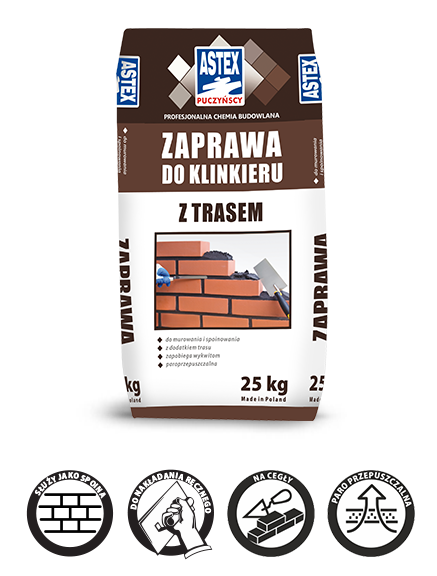Masonry mortar for clinker
Clinker mortar is intended for masonry and grouting of clinker brick walls, fences, chimneys, clinker tiles, etc.
- Available in graphite, gray, light gray, brown, dark brown, light brown
- For bricklaying and pointing
- With the addition of a route
- Prevents efflorescence
Calculate expenditure
grubość muru 12cm
grubość muru 12cm
Expenditure
Approx. 35 kg per m² with a wall thickness of 12 cm.
Shell life
12 months from the date of production
Packaging
25 kg
Application
Cement clinker mortar with the addition of a route is intended for masonry and grouting of clinker brick walls, fences, chimneys, clinker tiles, etc. It is used in ornamental and decorative construction, small and multi-purpose, both for new buildings and renovations. The addition of the Rhine route used in the mortar prevents efflorescence and discoloration on the weld and clinker bricks. Thanks to its properties, it combines elements into a stable and durable whole. The mortar is suitable for general use in general construction.
Properties
Clinker mortar is a ready, dry mix of the highest quality, based on high-quality gray cement class 52.5 R, sand, aggregates and modifying additives. Finished product - only requires mixing with water. It is characterized by very good workability, plasticity and adhesion to building materials, which makes it a product with a very versatile application and easy to process. With very high adhesion to the ground. A specially selected composition reduces the occurrence of shrinkage cracks. Clinker mortar is a frost and waterproof product. It is also characterized by high tightness and adhesion to surfaces with low water absorption. Full strength occurs 28 days after application.
Substrate preparation
The substrate should be dry, matured, stable, even and sound, i.e. strong enough, cleaned of layers that can weaken mortar adhesion (dust, dirt, lime, oils, fats, wax, residual oil and emulsion paint). If it is necessary to make a layer of mortar on solid substrates with a load capacity difficult to determine (e.g. dusty, difficult to clean), it is recommended to carry out an adhesion test consisting of applying a control layer and checking the connection after a minimum of 48 hours. Loose items must be removed. Blocks, bricks and highly absorbable elements should be wetted with water before laying in hot weather. It is recommended when erecting load-bearing walls to use elements of the same variety with the same strength class on one floor and the same type of mortar.
Mortar preparation
Preparation involves pouring dry mortar into the container with the right amount of water (4.0 - 5.5 l per 25 kg). Then mix the mass manually or mechanically using a low-speed drill with a mixer or concrete mixer until a homogeneous mass without lumps is obtained. Leave for about 5-10 minutes and mix again. If necessary - add a small amount of water and mix again to obtain the right consistency. The mass prepared in this way should be used within 1 to 2.5 hours depending on weather conditions. It is unacceptable to modify the mortar by adding other components of construction chemicals, e.g. sand, cement, and other additives, as it may cause loss of mortar properties.
Storage and transport
The products must be absolutely stored in undamaged packaging and dry rooms on pallets. Protect from moisture, getting wet during storage and transport. The storage period of the product in conditions complying with the recommendations given is up to 12 months from the date of production placed on the packaging in digital print. The date of production, which is placed on the packaging, is also the date of manufacture of the product. Any changes visible in the product or packaging structure without special tests, in particular discoloration or smudging of the packaging graphics, infringements of the packaging continuity, biological changes in the product structure, recognizable in particular as a consequence of moisture, may indicate poor storage or transport conditions and do not guarantee compliance declared performance characteristics of products as specified.
Application method
Clinker mortar is applied evenly with a trowel to the previously made layer. It is unacceptable to apply too thick layer exceeding the standard values in construction once. After applying the mortar, proceed to laying the material by lightly pressing. For more convenient laying of clinker material, use strips and spacers. When working outdoors, protect the applied layer from direct sunlight (drying out too quickly, which may lead to cracking of the mortar), as well as protect the joint from direct rain. The air and surface temperature must be positive (above + 5 ° C). In addition to the recommendations provided, work should be carried out in accordance with building practice and health and safety rules. Particular attention should be paid to the cleanliness of the work. If the mortar comes into contact with the clinker brick face, it must be removed and cleaned immediately. The manufacturer guarantees the quality of the product, but has no effect on the conditions and the way it is used. If in doubt, carry out adhesion tests. It should also be carefully filled with grout. The joint thickness should be the same for each layer and should be between 8 mm and 12 mm. The open time of the mortar for use is about 2 hours, so you should prepare enough to use it.
Expenditure
On average, 25 kg per 0.7 m² of wall is consumed with a joint thickness of about 1 cm and a wall width of one brick. In practice, the wear depends on the degree of thickness of the weld, as well as the dimensional accuracy of the joined elements.
Tools
Drill with a mixer, stirrer, trowel, concrete mixer. Tools should be cleaned with clean water directly after use.
Temperature of performed work
Air temperature from + 5 ° C to + 25 ° C. Substrate temperature from + 5 ° C to + 25 ° C. Work in temperature between +5 ° C and +25 ° C. For a period of 7 days after the completion of works, the air temperature should not be below +5 ° C, and for the next 21 should not fall below 0 ° C.
Packaging
Paper bags 25. Pallets: 54 bags, 25 kg each, 1350 kg overall per pallet.
Precautions
Irritating product. Appropriate eye, respiratory and skin protection should be used. Keep away from children. Do not breathe dust. In case of contact with eyes, rinse immediately with plenty of water and seek medical advice. If swallowed, seek medical advice immediately and show the container or label.
Do you have questions? Doubts? Ask an advisor Contact form












